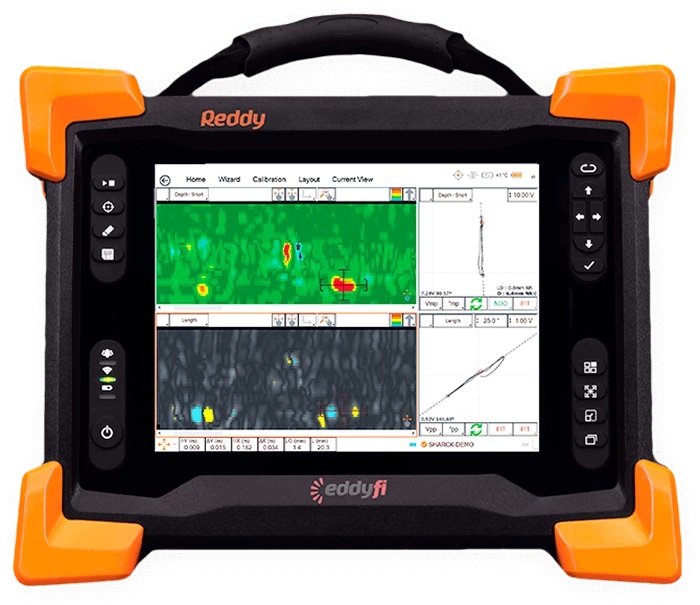
Reddy

Packaged with the latest technology, Eddyfi Reddy and its embedded data analysis software offer the most intuitive user experience, which includes real-time C-scans, a modern, rugged, and large multi-touch interface, as well as many other features that enable fast, high-PoD surface inspections.
Detecting and Sizing Cracks in Carbon Steel Welds
The Sharck is based on Tangential ECA (TECA™) technology, which was specifically developed for cracking in carbon steel. Not only does it enable measuring surface-breaking crack position and length, but also sizing cracks as deep as 7 mm (0.28 in). Furthermore, the Sharck allows simultaneously scanning the weld cap, toe area, and heat-affected zone for a longitudinal and transverse crack without surface preparation or paint removal.

Assessing Corrosion on Ferromagnetic Pipes, Tank Walls and More
MFL pipescans can adapt to a wide range of diameters (48 mm [1.9 in] to flat surfaces). The magnetic flux leakage option allows you to fully benefit from the Reddy® versatility in order to fast screen large areas for corrosion indications. The array of sensors provides large coverage and high-PoD. Liftoff and thick magnetic walls are now at reach.
Detecting and Sizing Cracks in Stainless Steel Welds
Padded ECA Probes adapt to geometry variations in almost every direction, making the probes perfect for examining weld beads, transitions, and Heat-Affected Zone (HAZ). The probe’s design enables detecting surface cracks 0.5–1 mm (0.02–0.04 in) long in welds with minimal surface preparation. The probe’s membrane is extra-tough to better withstand friction.
MFL pipescans can adapt to a wide range of diameters (48 mm [1.9 in] to flat surfaces). The magnetic flux leakage option allows you to fully benefit from the Reddy® versatility in order to fast screen large areas for corrosion indications. The array of sensors provides large coverage and high-PoD. Liftoff and thick magnetic walls are now at reach.
Padded ECA Probes adapt to geometry variations in almost every direction, making the probes perfect for examining weld beads, transitions, and Heat-Affected Zone (HAZ). The probe’s design enables detecting surface cracks 0.5–1 mm (0.02–0.04 in) long in welds with minimal surface preparation. The probe’s membrane is extra-tough to better withstand friction.
Assessing Corrosion on Aluminum and Stainless-Steel Tank Floors
Semi-flexible ECA probes can adapt to a tank floor’s curvature and other geometric features, offering sufficient penetration to scan through thick aluminum/stainless steel (over 6.35 mm [0.25 in] thick). So, doing, the solution is capable of detecting and characterizing corrosion-related defects such as pitting and thinning affecting as little as 10% of a plate’s thickness.
Detecting and Assessing Stress Corrosion Cracking in Base Metal
I-Flex™ probes are the most versatile probes in the industry. Thanks to their multiple built-in topologies and flexible bodies, they can address a variety of applications. I-Flex probes are perfect for detecting Stress-Corrosion Cracking (SCC) in both ferrous and non-ferrous materials. Whether SCC is affecting the integrity of pipelines, pressure vessels, or tanks (on base metal or internal cladding), encoded scans performed with I-Flex probes allow efficient sizing of clusters.
Specifications
GENERAL
Channels: 32, 64, or 128 (each available with MFL option)
Multiplexer: SmartMUX™
Acquisition/sampling rate: Up to 50 000 samples/s
Dimensions (W × H × D): 355 × 288 × 127 mm (14.0 × 11.3 × 5.0 in)
Weight: 6.6 kg (14.5 lb)
Display: 26.4 cm (10.4 in)
Non-reflective (AR coating)
Anti-fingerprint (oleophobic coating)
3 mm (0.12 in), chemically strengthened glass cover
Optically bonded LCD and touchscreen
Passive blacklight enhancement
Encoders
2 × axes, quadrature
Connectivity
Gigabit Ethernet, Wi-Fi™, Bluetooth®, HDMI, 3 × USB 2.0